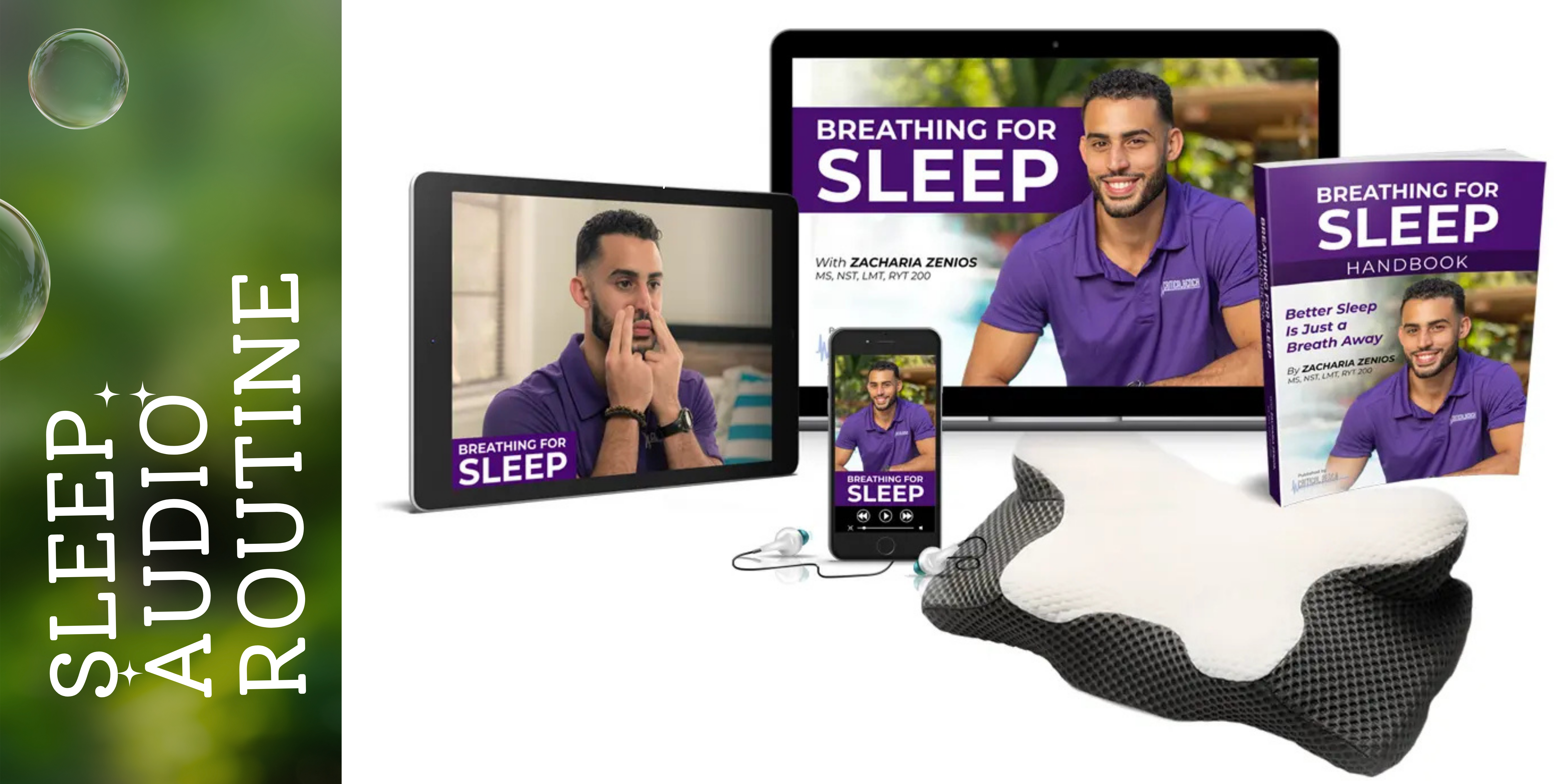Breathing for Sleep: A New Approach to Restful Nights
In today’s fast-paced world, sleepless nights are more common than ever. Many people struggle to fall asleep or stay asleep, and this can have serious consequences for both mental and physical health. Fortunately, there’s a unique, research-backed method that can help you sleep better without relying on pills, devices, or uncomfortable remedies. This method, known as "Breathing for Sleep," taps into a simple but effective breathing technique that has transformed sleep for thousands of people.
Introduction to Breathing for Sleep
For many, sleep issues are the result of racing thoughts or physical discomfort. This is where the Breathing for Sleep technique comes in. It focuses on a specific “tongue trick” that relaxes your body and mind, allowing you to fall asleep faster and stay asleep longer. What makes it unique is that it doesn’t require you to give up caffeine or wear uncomfortable devices like sleep apnea machines. Instead, it relies on simple breathing exercises that target your sleep nerve, bringing immediate relief.
Key Benefits of Breathing for Sleep
Eliminates Disruptive Snoring
One of the most immediate benefits of the Breathing for Sleep method is its ability to reduce or eliminate snoring. Snoring happens when your tongue obstructs your airway, causing the air to collide with the narrow opening. This breathing technique corrects your tongue posture, ensuring that your airways stay open throughout the night.
Improves Sleep Quality
This technique doesn't just help you fall asleep faster; it also enhances the quality of your sleep. By ensuring proper airflow and oxygen delivery, it allows for deeper, more restorative sleep. You’ll wake up feeling refreshed, with more energy to face the day.
Supports Mental and Physical Health
Breathing for Sleep has far-reaching benefits beyond just better sleep. Proper oxygen flow to the brain, heart, and muscles ensures that your body remains in a relaxed state, which reduces stress levels and promotes overall health. It also helps prevent neck pain and forward head posture, two common issues related to poor sleep habits.
How the Breathing for Sleep Technique Works
The core of this method is a simple yet effective tongue exercise that unlocks a critical sleep nerve. This nerve, when activated correctly, allows for deeper breathing and better oxygen flow. The result? You fall asleep faster and sleep more soundly.
The Science Behind the Technique
This breathing technique is backed by research from leading institutions like Harvard University and the University of Oxford. Studies have shown that stimulating certain nerves in the body can double feelings of sleepiness and improve overall sleep quality.
How It Affects Your Brain
During sleep, your brain goes through various cycles, including REM sleep. Proper breathing ensures that your brain gets the oxygen it needs, which is crucial for maintaining these cycles. This, in turn, leads to more restful, uninterrupted sleep.
Steps to Implement Breathing for Sleep
The 10-Minute Routine
The Breathing for Sleep method involves a 10-minute routine that you can practice before bed. By focusing on controlled breathing and tongue posture, you’ll begin to notice improvements in your sleep quality almost immediately.
Step 1: Start by taking deep breaths, inhaling through your nose and exhaling through your mouth. This helps open your airways and prepares your body for rest.
Step 2: Use the "tongue trick" to stimulate the sleep nerve. Position your tongue against the roof of your mouth, just behind your teeth, and hold it there while you continue to breathe deeply.
Common Mistakes That Can Sabotage Your Sleep
Even though the Breathing for Sleep technique is simple, there are a few common mistakes that people make that can prevent them from getting the full benefits. The three worst bedtime mistakes are:
Using Melatonin Supplements
While melatonin supplements can help some people, they often lead to a 200% disruption in sleep patterns for others. This is because they can "fry" your sleep receptors, making it harder for you to fall asleep naturally in the long run.
Consuming Stimulants Before Bed
Consuming caffeine or alcohol too close to bedtime can wreak havoc on your sleep cycle. These substances stimulate your brain, making it more difficult for you to fall asleep or stay asleep. By focusing on breathing techniques instead, you can avoid these sleep disruptions.
Using Electronics Late at Night
Blue light from phones and other electronics can interfere with your body’s natural production of melatonin. To avoid this, try limiting screen time before bed and focus on your breathing exercises instead.
Why Your Tongue is the Key to Better Sleep
Many people are surprised to learn that their tongue plays a major role in their sleep quality. Your tongue can obstruct your airway, leading to snoring and interrupted sleep. By correcting your tongue posture with the Breathing for Sleep technique, you can open up your airway and enjoy better sleep.
How Your Tongue Affects Your Airway
When you sleep, your muscles relax, including your tongue. If your tongue falls back into your throat, it can block your airway, causing you to snore or even stop breathing temporarily.
This obstruction can lead to various sleep conditions, including sleep apnea, which can drastically affect your sleep quality. The Breathing for Sleep technique specifically targets this issue by training your tongue to stay in a position that keeps your airway clear.
Identifying Tongue-Related Sleep Issues
To determine if your tongue is causing your sleep issues, consider taking a simple quiz. Ask yourself questions like: Do you snore? Do you wake up feeling unrested? Do you often find yourself gasping for air during sleep? If you answered yes to these questions, it’s highly likely that your tongue position is affecting your sleep.
Breathing Exercises: A Comprehensive Guide
In addition to the specific techniques for sleep, there are various breathing exercises you can incorporate into your daily routine to enhance your overall well-being and promote better sleep. These exercises can reduce anxiety, improve lung capacity, and increase your body’s relaxation response.
Types of Breathing Exercises for Sleep
1. **Diaphragmatic Breathing:** This involves breathing deeply into your diaphragm rather than your chest. To practice, place one hand on your chest and the other on your stomach. Inhale deeply through your nose, allowing your stomach to rise while keeping your chest still. Exhale slowly through your mouth. This technique calms the nervous system and prepares your body for sleep.
2. **Box Breathing:** This technique, used by athletes and military personnel, involves inhaling, holding, exhaling, and holding your breath for equal counts. For example, inhale for 4 seconds, hold for 4 seconds, exhale for 4 seconds, and hold again for 4 seconds. This method promotes relaxation and helps to center your thoughts.
Breathing for Sleep Coaching Video
To make it even easier for you to adopt this new method, a Breathing for Sleep Coaching Video is available. This video walks you through the entire process, offering a visual guide to the breathing techniques and tongue exercises. The coaching video will empower you with the knowledge to improve your sleep quality without any guesswork.
Features of the Coaching Video
The video includes:
1. A Step-by-Step Guide: You’ll learn the 10-minute routine to implement right before bed.
2. Additional Techniques: Discover various breathing techniques that enhance relaxation and sleep quality.
3. Insights from Experts: The video is backed by research from leading institutions, ensuring you receive credible information.
Breathing for Sleep Audio Routine
For those who prefer a simpler approach, an audio version of the Breathing for Sleep routine is also available. You can easily play this audio guide on your phone, tablet, or TV and follow along each night before bed. The soothing voice will help guide you through the breathing exercises, allowing you to drift off into a peaceful slumber within minutes.
Understanding Sleep Apnea and Its Impact
Sleep apnea is a serious condition that affects many people and can severely impact overall health. It’s characterized by repeated interruptions in breathing during sleep, often leading to loud snoring and gasping for air. Many individuals suffering from sleep apnea may not even realize they have it, as symptoms can occur during deep sleep.
The Role of Breathing Techniques in Managing Sleep Apnea
While it’s essential to seek professional medical advice for sleep apnea, implementing breathing techniques can serve as an excellent complementary approach. By training your tongue to maintain an open airway and practicing controlled breathing, you can help alleviate some of the symptoms associated with sleep apnea.
FAQs About Breathing For Sleep
1. What is Breathing for Sleep?
Breathing for Sleep is a technique that combines specific breathing exercises and tongue positioning to enhance sleep quality. It focuses on controlling your breath to calm your mind and open your airways, allowing for deeper, more restorative sleep.
2. How does breathing affect sleep quality?
The way you breathe can significantly impact your sleep quality. Shallow or erratic breathing can lead to increased stress and anxiety, making it harder to fall asleep. On the other hand, deep breathing techniques promote relaxation and help regulate your heart rate, leading to better sleep.
3. Can breathing exercises help with insomnia?
Yes, breathing exercises can be an effective natural remedy for insomnia. Techniques such as diaphragmatic breathing and box breathing can calm the nervous system, making it easier for individuals to drift off into sleep.
4. What is the best breathing technique for falling asleep quickly?
One of the most effective techniques for quickly falling asleep is the 4-7-8 breathing method. Inhale for 4 seconds, hold for 7 seconds, and exhale for 8 seconds. This technique helps to relax the mind and body, making it easier to fall asleep.
5. Can I use breathing techniques if I have sleep apnea?
While it's important to consult with a healthcare professional regarding sleep apnea, incorporating breathing techniques can complement traditional treatments. They may help to alleviate some symptoms and improve overall sleep quality by promoting a clear airway.
6. Is there a connection between mouth breathing and sleep issues?
Absolutely. Mouth breathing during sleep can lead to snoring and disrupt your sleep cycle. It can also dry out your throat and contribute to other issues, like sleep apnea. Practicing nasal breathing techniques can help alleviate these problems.
7. How often should I practice breathing exercises for optimal results?
For the best results, it's advisable to practice breathing exercises daily. Incorporate them into your bedtime routine to signal to your body that it's time to wind down. Consistency is key to improving your sleep quality over time.
8. Are there any side effects to using breathing techniques?
Generally, breathing techniques are safe and have no adverse side effects. However, if you have any pre-existing respiratory conditions, it's essential to consult a healthcare provider before starting a new breathing regimen.
9. Can breathing exercises help with anxiety and stress?
Yes, breathing exercises are well-known for their ability to reduce anxiety and stress. By focusing on your breath, you activate the body’s relaxation response, which can help lower cortisol levels and calm racing thoughts, making it easier to transition into sleep.
10. How long does it take to see results from breathing exercises for sleep?
Many individuals notice improvements in their sleep quality within a few days of practicing breathing exercises. However, for lasting results, it’s recommended to incorporate these techniques into your nightly routine consistently.
Conclusion on Breathing for Sleep
In conclusion, if you’ve been struggling with sleep, the Breathing for Sleep technique offers a natural, effective solution. By focusing on your breathing and tongue posture, you can significantly improve your sleep quality and overall well-being. It’s a simple yet profound method that doesn’t rely on medications or uncomfortable devices.
Imagine waking up every morning feeling refreshed and ready to take on the day. With the right breathing techniques, this can be your reality. Take the first step towards better sleep tonight by incorporating these methods into your routine.
Don’t let sleepless nights control your life any longer. Try Breathing for Sleep and discover the restful nights you’ve always wanted!

ProDentim - Dental Niche
Price : $ 69+
3 Unique ingredients to support the health of your teeth and gums.

Cortexi - Hearing & Brain Health
Price : $ 69+
Over 20 Carefully-Selected Ingredients That Support Healthy Hearing.


